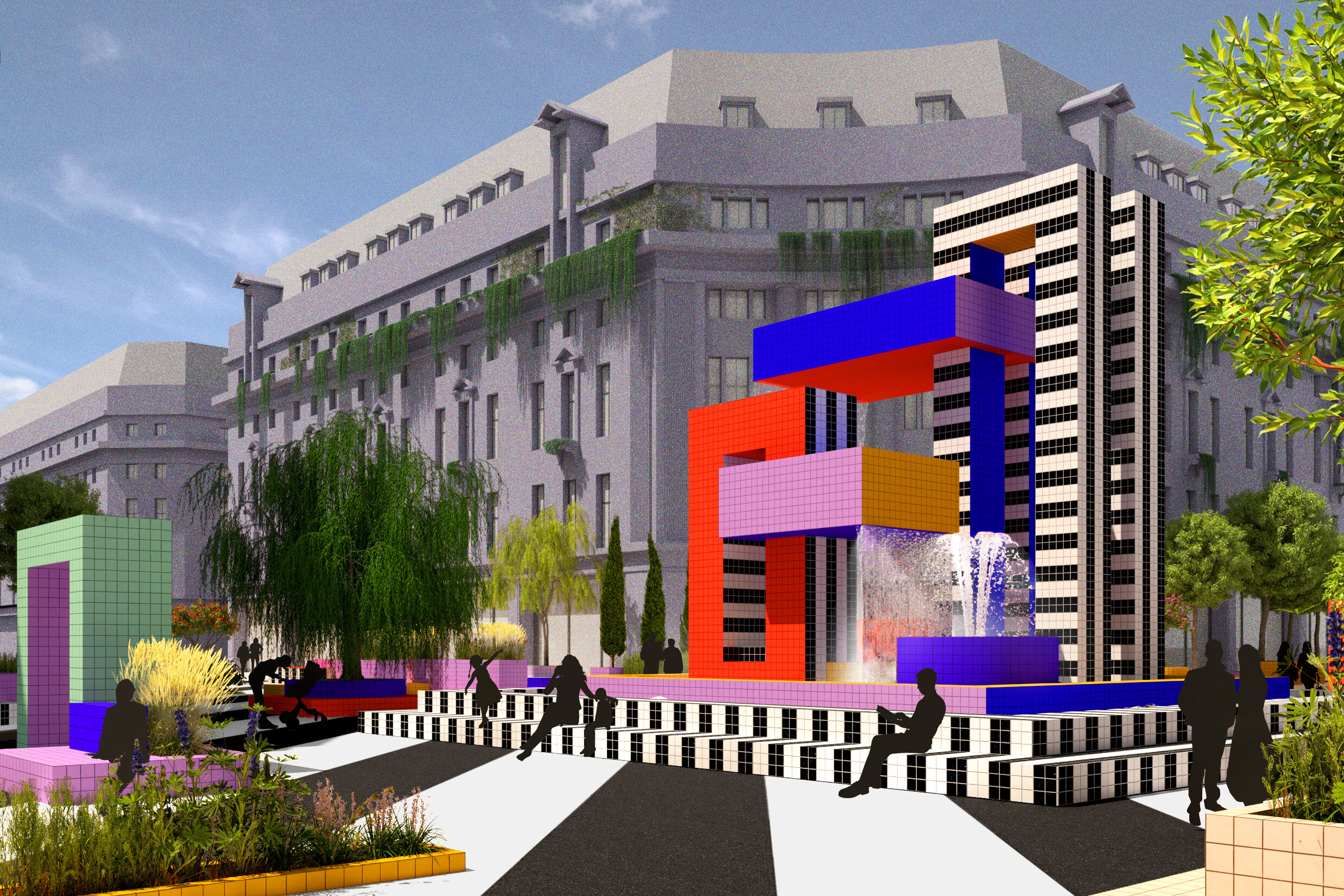Utopia
It’s the early days of lockdown and Camille Walala and creative producer Julia Jomaa are cycling the empty streets of the capital. In the absence of traffic and bustle, London has become an extraordinarily peaceful place, and the two of them start to wonder whether the city of the future might look similar.
Now, eight months later, Camille unveils the results of this speculation: a series of images depicting Oxford Street as it has never been seen before. Pedestrianised, exploding with colour and full of imaginative street furniture designed to be interacted with in multiple ways, Camille’s Oxford Street is a place of joy, surprise and asymmetry – an antidote to the flatness and homogeneity that often characterise the standard high street.
In a letter accompanying the series, Camille reflects on her 23 years living in London, and credits the capital with sparking and shaping her career as an artist. This project, she explains, is in essence an expression of her love and gratitude for the city, as well as a serious proposal for a new, more enriching urban landscape. Full of colourful, bold architectural structures and 3D surfaces, the images present a vision of an urban thoroughfare that exists for more than practical purposes, inviting numerous forms of interaction. It’s a place for gathering and meeting, resting and rambling – evoking the multiple community functions of the agora, or public square, in ancient Greece. Walala imagines the space as somewhere the natural and the human-made can coexist and complement each other, weaving water and verdant plant life into her speculative streetscape.
Camille Walala: a letter to London
I have been in love with London for 23 years, ever since I first came here from France in 1997. Back then, my English wasn’t great and I wasn’t really sure what I was doing with my life – in time, London fixed both of these things.
I was supposed to go home after three months, but the city had me hooked. London has an energy and creativity unlike anywhere else in the world. In East London, the people I met seemed full of vision and possibility – in that sort of atmosphere, you get the feeling that anything might happen. In London, I’ve always felt free.
It hasn’t always been easy, however. There were times in the early days when I came close to packing up and leaving, but in 2012 – London’s great year of optimism – my career as an artist suddenly began to take shape. I found myself with more and more opportunities to develop my practice and ideas – to play with pattern and colour at larger and larger scales. If I’d lived somewhere else, if I’d not been rooted in London’s creative scene, surrounded by the people I was, I don’t know if I’d even have become an artist.
So I feel nothing but love and gratitude for the city that shaped me, and my desire to give something back to it has grown more intense in the last few years. Earlier this year, I began to think more and more about the power that artists have to create – not just individual artworks – but entire environments that are positive and inspiring, and I started exploring ways that my own work could improve the urban landscape.
In August, working on Walala Parade in Leyton – the community-led, crowd-funded transformation of an entire street – was especially inspiring for me. It was wonderful to play a part in something that had such a dramatic positive effect on the urban landscape. I am convinced that, together, we can do much more like this, and make our cities wonderful, engaging places that are as emotionally enriching as they are practically functional.
At the beginning of lockdown earlier this year, I was cycling around the city with my partner, Julia. We were struck by the silence of the streets, the sense of peace that had descended on London in the absence of the traffic, and we started talking about how cities might be fundamentally different. We decided to devote some of our time in lockdown to this speculative project – a visualisation of a better, brighter city. Iconic, but notoriously busy, Oxford Street was the obvious starting point – what might it be like if there were no cars but more greenery? What if there were spaces and structures that people could interact with however they liked? What if Oxford Street made you happy?
This project is my what-if portrait of the city of tomorrow, and my own projection of what the London I love might one day look like. In times such as these, when the future is uncertain, strain on mental health is high, and many of us are facing tough challenges in our lives, I believe it’s crucial to hang on to what hope we can for the future, and to spread joy in the present. That’s what I’ve tried to do with my vision for Oxford Street, and that’s, ultimately, what all my art is for. This city has taught me that.
So, thank you London, this one’s for you.
Camille Walala





